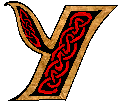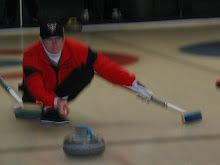 is for Yellow, a common identifying colour for curling rocks. At one time, curlers owned their own rocks, and brought them to the rink for each game. Everybody's rocks were different, and one became familiar with the way one's rocks behaved on the ice. Different stones would go farther, or stop sooner. They might curl more, or less than other people's rocks. As the game evolved, and rules became more universally standardized, and clubs accquired their own buildings and facilities, privately owned rocks fell by the wayside. A friend of mine recently mentioned to me that he has one of his grandfather's old curling stones propping open a door in his house in St. Catherines.
is for Yellow, a common identifying colour for curling rocks. At one time, curlers owned their own rocks, and brought them to the rink for each game. Everybody's rocks were different, and one became familiar with the way one's rocks behaved on the ice. Different stones would go farther, or stop sooner. They might curl more, or less than other people's rocks. As the game evolved, and rules became more universally standardized, and clubs accquired their own buildings and facilities, privately owned rocks fell by the wayside. A friend of mine recently mentioned to me that he has one of his grandfather's old curling stones propping open a door in his house in St. Catherines.
The goal of any modern curling club is to have all of thier rocks behave the same way on the ice. In reality, that turns out to be something of an impossible dream. There are just too many variables involved, and miniscule variations in the texture of the running surface can result in dramatic differences in how far a rock will travel, or curl. Most icemakers will spend a not insignificant amount of time throwing all the rocks in the club, and trying to pair up - or 'match' - identically running rocks to make sets of eight that will be at least similar to each other during game play. This is an exhaustingly laborious undertaking, and as such, most clubs rocks will be matched in only the most rudimentary manner. And that doesn't even take into account the fact that a rock's behaviour might change over time as it's running surface wears.
At large national and international curling events being contested by the best teams in the world, exceptional care is taken to ensure the curlers are playing with the best possible rocks. The Canadian Curling Association keeps a set of top quality stones that they transport around the country for use at major CCA sanctioned events. Before, say, the Brier national championship, the stones will be carefully matched so the players can have the best possible experience on the ice. With all this care, the players still find minor differences between the rocks, and will often swap rocks around in throwing order based on how they believe they will behave under different circumstances. During the course of the week at one of these events, as teams play on each different sheet of ice, using each different set of rocks, they will meticulously chart the performance of the stones. Should they reach the finals, they will be allowed to select any of the rocks from across the rink to assemble a set of eight they like.
At most organised bonspiels, rock colour is preselected for the teams before they go on the ice. During regular in-club league play, however, the team who is throwing first as determined by the coin toss will usually select whether to throw blue or yellow rocks. Regular club curlers will often have their own opinions which colour rocks are better to choose on any given sheet based upon prior experience. Of course, during the off season, the rocks might be stored without handles, and reassembled in a different order the next year. Or, the running surfaces might be retextured at some point, which changes everything. Each team starts a new year in club curling having to suss out the rocks all over again before they come to a conclusion, like: "on ice two, don't take blue!"
<- Start at the beginning.
July 27, 2010
The ABCs of Curling - Y
Labels:
ABCs of curling
Subscribe to:
Post Comments (Atom)







0 comments:
Post a Comment